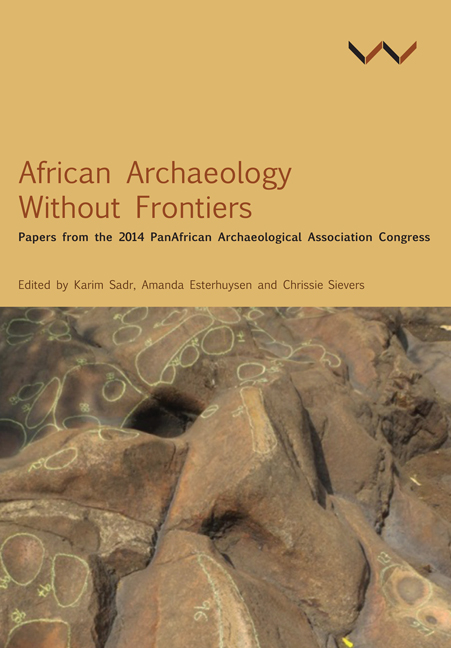 African Archaeology Without Frontiers
African Archaeology Without Frontiers Book contents
- Frontmatter
- Contents
- Acknowledgements
- List of Figures and Tables
- Introduction: An Invitation Fulfilled
- Keynote Address 1: Imagining an African Archaeology Without Frontiers
- Keynote Address 2: A Continental Vision for African Archaeology
- 1 The ‘Useable’ Archaeology of African Farming Systems
- 2 Defining Cultural Heritage among the Makonde of Tanzania
- 3 The Indigenous Roots of Swahili Culture in Pangani Bay, Tanzania
- 4 Is This an Anvil? Iron Bloom Crushing Sites in Northern Togo
- 5 L'art Rupestre au Cameroun, Nouvelles Découvertes et Contribution à L'iconographie Sous-Régionale
- 6 Archaeology and History in Iron Age Settlements in the Congo Basin
- 7 Learning from Glass Trade Beads at Thabadimasego, Botswana
- 8 Blurring Boundaries: Forager–Farmer Interactions in the Middle Limpopo Valley
- 9 Heritage Management and the World Wide Web: South African Challenges
- Contributors
- Index
5 - L'art Rupestre au Cameroun, Nouvelles Découvertes et Contribution à L'iconographie Sous-Régionale
Published online by Cambridge University Press: 15 March 2018
- Frontmatter
- Contents
- Acknowledgements
- List of Figures and Tables
- Introduction: An Invitation Fulfilled
- Keynote Address 1: Imagining an African Archaeology Without Frontiers
- Keynote Address 2: A Continental Vision for African Archaeology
- 1 The ‘Useable’ Archaeology of African Farming Systems
- 2 Defining Cultural Heritage among the Makonde of Tanzania
- 3 The Indigenous Roots of Swahili Culture in Pangani Bay, Tanzania
- 4 Is This an Anvil? Iron Bloom Crushing Sites in Northern Togo
- 5 L'art Rupestre au Cameroun, Nouvelles Découvertes et Contribution à L'iconographie Sous-Régionale
- 6 Archaeology and History in Iron Age Settlements in the Congo Basin
- 7 Learning from Glass Trade Beads at Thabadimasego, Botswana
- 8 Blurring Boundaries: Forager–Farmer Interactions in the Middle Limpopo Valley
- 9 Heritage Management and the World Wide Web: South African Challenges
- Contributors
- Index
Summary
Abstract (Rock Art in Cameroon: Knowledge, New Discoveries and Sub-Regional Iconography)
Our research since 2009 has led us to a dozen rock art sites in the Adamaoua in central Cameroon. The iconographic repertoire of these sites is made up of weapon designs and rock games with protohistorical references. This breaks away from the older tradition of ‘abstract’ geometric figures from Bidzar in the north of the country. With these discoveries, Cameroon is now part of an extended central African network that has known a remarkable Iron Age as testified to by the frequent representation of metal weapons. A summary of knowledge on rock art in Cameroon shows that the variety of representation styles and themes seems to reflect that of cosmological and semiological systems. As such, currently available iconography makes it possible to distinguish three representation styles: the ‘abstract’ geometric style of ‘mythogram’ found in Bidzar; the ‘algebraic’ geometric style of ‘ludogram’ (rock game) localised from the Mandara mountains to Adamaoua; and the schematic style of ‘pictogram’ corresponding to a phonographic system in the Adamaoua. These representations have been partially decrypted with reference to comparative ethnology and in the light of oral traditions.
Introduction
Trouvés dans des circonstances bien souvent inégales, les arts rupestres de l'Afrique centrale révèlent de plus en plus leur richesse et leur diversité grâce au regain d'intérêt des programmes scientifiques de recherches qui apportent des résultats satisfaisants et encourageants dans presque tous les pays de la sous-région. Si certaines représentations ici manifestent un intérêt particulier parce qu'elles se rapportent à une ethnologie encore bien vivante dans plusieurs localités, des lacunes considérables existent cependant toujours pour ce qui concerne la restitution des séquences chronologiques y afférentes. Au Cameroun, le premier site d'art rupestre a été mis à jour par Buisson en 1934 à Bidzar, dans la partie soudano-sahélienne du pays. Dès lors, la plupart des travaux se sont concentrés dans cette zone mais sans grands résultats.
Dans le cadre de notre thèse, nous avons orienté nos recherches dans d'autres régions tropicales humides du Cameroun où se localisent d'importants gisements de latérite, roche la plus gravée en Afrique centrale ; c'est ainsi que nous avons pu trouver dès 2009 une dizaine de sites concentrés du centre au sud-est du plateau de l'Adamaoua, zone de transition savane-forêt.
- Type
- Chapter
- Information
- African Archaeology Without FrontiersPapers from the 2014 PanAfrican Archaeological Association Congress, pp. 85 - 113Publisher: Wits University PressPrint publication year: 2016
